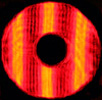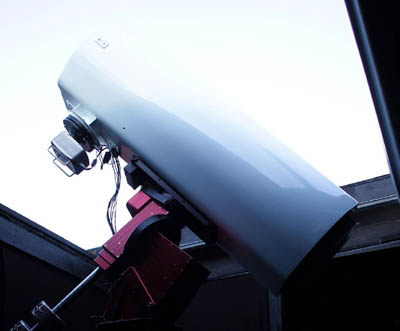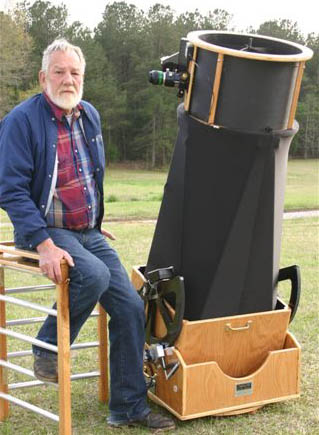



Sometimes things just seem to take care of themselves. This is the story of one telescope mirror that ended up in two clients' product lines due to a little luck, good timing, and forward thinking.

A bit over a year ago as of the writing of this page, Shane Santi, owner and founder of Dream Telescopes and Accessories, Inc., ordered ten 16.5"-diameter Pyrex mirror blanks. They were 1.25" thick, and with a radius of curvature of 60" (F/3.63).
Shane was very concerned about the optical quality of these mirrors, and he had specified 16.5" to guarantee that he would have 16" of clear aperture free of a rolled edge. (At this point Shane had not taken delivery of one of my optics, he didn't know that I could make such a mirror good to the edge, and he was taking nothing for granted.) Shane's commitment to quality optics greatly impressed me, and it was clear that my philosophy on quality optics meshed nicely with his desire to produce the best imaging instruments.
A few months later, I had delivered four of these mirrors, and Shane was planning the telescope structures and beginning to make parts. Shane had also decided that he wanted all-cellular optical sets from this point on, to maximize the benefit of fast cooling and to minimize weight of his instruments. As I started work on Shane's first 24" F/3.5 cellular mirror blank (weighing only 40 pounds), we pondered over what to do with the remaining 16.5" blanks.....
Update: The 16" Dream Astrograph is now in use, and is taking excellent images. Click this link to see images acquired with a 16" Dream Astrograph. (Additional and future images from this telescope/owner can be found on this page. There are images from many telescopes posted there, so look for Dream 16" in the caption.)
I first talked to Rick Singmaster, owner of Starmaster Portable Telescopes, at Okie-Tex 2007. While standing next to our 30" telescope, I had a conversation with Rick about optics, testing, life in general, and the beautiful skies at the star party. Rick had to leave the next day, and was busy helping update a customer's telescope. It was several months later, in early 2008, that Rick and I began to talk in earnest about a collaboration, and the FX line of Starmaster Telescopes was conceived. Because no one was regularly producing mirrors smaller than 22" in sub-F/4 focal ratios, Rick and I saw a unique opportunity to offer telescopes that could be used with much shorter or no ladders, that would make no optical compromises, and that would work well for video astronomy due to their fast focal ratio.

My personal experience with seated, high-quality observing using my own 16" F/4 was music to Rick's ears (and back), and at first we decided to offer an 18" F/3.7 telescope with a "normal" thickness mirror, a stout 1.6" thick. This mirror was completed just after I got back from the Winter Star Party, 2008. (See this link for a customer's article about one of the first 18" F/3.7 FX telescopes.)
I believe it was during production of the first 18" FX mirror, some time during a cold January of 2008, that Rick and I had a conversation that I remember well. It went something like this:
And thus was born the 16.5" F/3.7(ish) FX telescope with a 1.25" thick mirror.
The first Starmaster 16.5" F/3.7 primary was delivered to Rick a few months later, and I still remember the phone call from Rick after he tested it the first time; he was so happy, like a kid in a candy store. Now it is his favorite scope to use, and his biggest problem is having one on hand for him to use... but he keeps selling his "personal" telescope!
Some will claim that such a mirror will bend too easily, and can't be properly figured. I know otherwise - so far I have produced nine of these mirrors with no astigmatism problems in the glass. They pass my sensitive figure-of-revolution test quite splendidly, a test that I do before and after figuring.
Others may also claim, without any facts to back their claims up, that such mirrors (and even thicker mirrors) will be warped into astigmatic shapes by the mirror cells. However, a properly made cell will cause no such distortion according to my own experience in testing, Rick's testing of every telescope before shipping it, and Rick's very, very happy clients who are lucky enough to already have a 16.5" FX telescope. Some very interesting work by Robert Houdart also shows that there are a number of ways to properly support thin mirrors so that they do not become distorted by their edge/lateral support when they are pointed near the horizon. Before claiming that it can't be done, the negativists should read and fully understand Robert's work.
Clearly those who bemoan telescopes with such thin mirrors have never appreciated the thermal advantages that come with them, which greatly outweigh any disadvantages of the "thin" glass. The clearest example of this was exhibited by Rick Singmaster himself, who commented on being able to easily see the 5th and 6th stars in the trapezium (in M42) after bringing the telescope outside from a warm house into a cold winter's night and letting it cool for less than an hour! For a telescope of 16"+ in aperture, this is nearly miraculous, and it will allow those with limited time to make the most of their observing.
To me, the 16.5" FX telescope represents the fastest cooling large-aperture visual telescope on the market, and it is the ideal instrument for those who want a mid-aperture telescope that they can set up for a short evening of observing, and get good images from before they have to go to sleep. It is also ideal for anyone whos has more time, but who wants a compact, lightweight instrument in this size range.
So, there you have it, now you know how the choice of a "thin" mirror blank by one forward-thinking American company led to the creation of another telescope by a manufacturer who is not afraid to go against "conventional thinking", and make a product that observers will love to use for years to come. As a bonus, the mirror and both telescope companies are located here in the good old USA.
Mike Lockwood